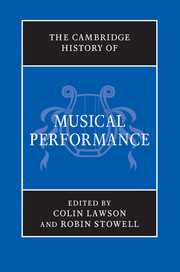Book contents
- Frontmatter
- PART I PERFORMANCE THROUGH HISTORY
- PART II PRE-RENAISSANCE PERFORMANCE
- PART III PERFORMANCE IN THE RENAISSANCE (C. 1430–1600)
- 12 Performance in the Renaissance: an overview
- 13 Vocal performance in the Renaissance
- 14 Instrumental performance in the Renaissance
- 15 Case study: Seville Cathedral's music in performance, 1549–1599
- PART IV PERFORMANCE IN THE SEVENTEENTH CENTURY
- PART V PERFORMANCE IN THE ‘LONG EIGHTEENTH CENTURY’
- PART VI PERFORMANCE IN THE NINETEENTH CENTURY
- PART VII THE TWENTIETH CENTURY AND BEYOND
- PART VIII
- Index
14 - Instrumental performance in the Renaissance
from PART III - PERFORMANCE IN THE RENAISSANCE (C. 1430–1600)
Published online by Cambridge University Press: 28 March 2012
- Frontmatter
- PART I PERFORMANCE THROUGH HISTORY
- PART II PRE-RENAISSANCE PERFORMANCE
- PART III PERFORMANCE IN THE RENAISSANCE (C. 1430–1600)
- 12 Performance in the Renaissance: an overview
- 13 Vocal performance in the Renaissance
- 14 Instrumental performance in the Renaissance
- 15 Case study: Seville Cathedral's music in performance, 1549–1599
- PART IV PERFORMANCE IN THE SEVENTEENTH CENTURY
- PART V PERFORMANCE IN THE ‘LONG EIGHTEENTH CENTURY’
- PART VI PERFORMANCE IN THE NINETEENTH CENTURY
- PART VII THE TWENTIETH CENTURY AND BEYOND
- PART VIII
- Index
Summary
Between 1430 and 1600 performance practice for instrumental musicians turned on its head. The watershed development for players (and of course for music in general) was the arrival of a compositional approach which was based on the notion of through imitation as the basic texture. This took place just before 1500, and after this the ground rules for performers changed fundamentally. The purpose here will be to trace the course of how these changes played out. With the key date of 1500 providing the frame of reference, this study will divide into two parts. The first considers the development of the instruments, ensembles and performance techniques of the fifteenth century. This span in essence may be viewed as a culmination of medieval traditions. The second takes up what followed in the sixteenth century, a period in which tradition and innovation time and again came into sharp conflict.
Instrumental practices c. 1430–1500
Instrumentalists in the fifteenth century performed almost entirely without written music. Because they worked without music, their practices have remained veiled – but other sources, iconographical, theoretical and archival, tell us a great deal. We know that in the fifteenth century the tradition of the distinction of two categories of instruments (haut and bas, or loud and soft) held sway. The soft instruments were those with gentler timbres, the most important being the fiddle, the lute, the harp and the portative organ.
- Type
- Chapter
- Information
- The Cambridge History of Musical Performance , pp. 335 - 352Publisher: Cambridge University PressPrint publication year: 2012

